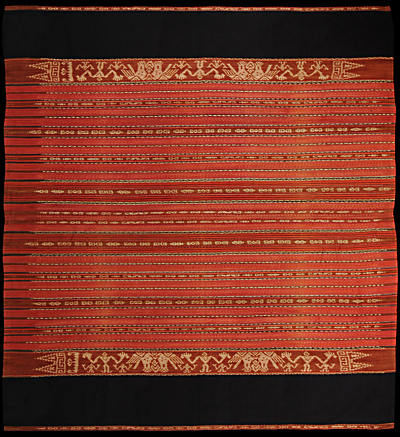| |
 
 | | | |
134 Moluccas, Kisar
Homnon (sarong) 
| | Locale: | Probably Oirata people. | | Period: | 1910-1930 | | Yarn: | Cotton, largely hand-spun | | Technique: | Warp ikat | | Panels: | 2 | | Size: | 134 x 157 cm (4' 4" x 5' 1") LW: 1.17 | | Weight: | 630 g (22.2 oz), 150 g/m2 (0.49 oz/ft2) | | Design: | Rimanu motif, reserved for aristocracy, consisting of human figures standing with raised hands, and twin eagles, with base-mounted tumpal motifs as finials. The two eagles are a rudimentation, or a creative reimagination Kisar's tradtional double-eagle motif, which itself is an emulation of European heraldry as seen on coins—pärticularaly the Maria Theresien Thaler of the Austrian-Hungarian empire. The thaler (the inspiration for the 'daalder', 'dollar', etc.) was a widely accepted currency in the Indonesian archipelago since the 18th c. Hundreds of millions were in ciculation. Narrow horizontal bands decorated with small squares and circles in white on brick red, two wider bands in very dark, nearly black indigo. | | Comment: | All ikat work was done in hand-spun yarn, and with a high degree of precision; the pinstripes were made with pre-dyed commercial thread. The dimensions given reflect the fact that the sarong was opened up for display. | | Background: | Chapters on Moluccas and Kisar. | | Published: | Ikat Textiles of the Indonesian Archipelago, 2018.
| | Compare: | 101 102 103 282 | | Sources: | Nearly identical to sarong in Khan Majlis, Woven Messages, Fig 311, similar to one on Fig. 310. Similar cloth in Tropenmuseum, Tillman collection, Nr. 3848-1, though ours is several decades older. Very similar to Pusaka Collection Nr. 101, 102 and 103. See also Fraser Lu, Handwoven Textiles of South-East Asia, Fig. 260. | | |

©Peter ten Hoopen, 2024
All rights reserved.
|
|


